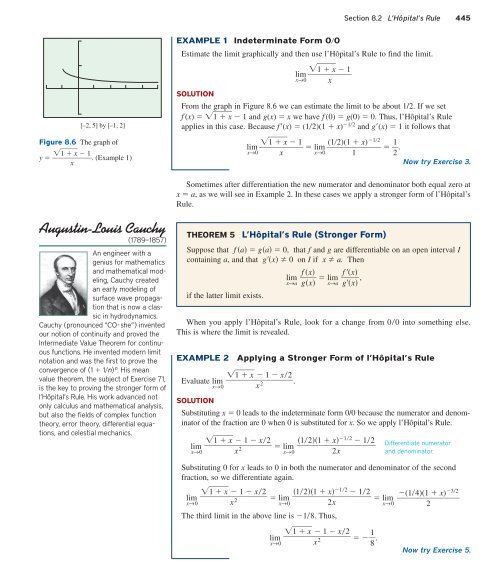You also want an ePaper? Increase the reach of your titles
YUMPU automatically turns print PDFs into web optimized ePapers that Google loves.
Section 8.2 L’Hôpital’s Rule 445<br />
EXAMPLE 1 Indeterminate Form 00<br />
Estimate the limit graphically and then use l’Hôpital’s Rule to find the limit.<br />
lim 1 x 1<br />
<br />
x→0 x<br />
[–2, 5] by [–1, 2]<br />
Figure 8.6 The graph of<br />
y 1 x 1<br />
. (Example 1)<br />
x<br />
SOLUTION<br />
From the graph in Figure 8.6 we can estimate the limit to be about 1/2. If we set<br />
f (x) 1 x 1 and g(x) x we have f (0) g(0) 0. Thus, l’Hôpital’s Rule<br />
applies in this case. Because f(x) (12)(1 x) 12 and g(x) 1 it follows that<br />
lim 1 x 1<br />
lim (12)(1 x)<br />
12<br />
1 x→0 x<br />
x→0 1 2 . Now try Exercise 3.<br />
Sometimes after differentiation the new numerator and denominator both equal zero at<br />
x a, as we will see in Example 2. In these cases we apply a stronger form of l’Hôpital’s<br />
Rule.<br />
Augustin-Louis Cauchy<br />
(1789–1857)<br />
An engineer with a<br />
genius for mathematics<br />
and mathematical modeling,<br />
Cauchy created<br />
an early modeling of<br />
surface wave propagation<br />
that is now a classic<br />
in hydrodynamics.<br />
Cauchy (pronounced “CO-she”) invented<br />
our notion of continuity and proved the<br />
Intermediate Value Theorem for continuous<br />
functions. He invented modern limit<br />
notation and was the first to prove the<br />
convergence of (1 1n) n . His mean<br />
value theorem, the subject of Exercise 71,<br />
is the key to proving the stronger form of<br />
l’Hôpital’s Rule. His work advanced not<br />
only calculus and mathematical analysis,<br />
but also the fields of complex function<br />
theory, error theory, differential equations,<br />
and celestial mechanics.<br />
THEOREM 5<br />
L’Hôpital’s Rule (Stronger Form)<br />
Suppose that f a ga 0, that f and g are differentiable on an open interval I<br />
containing a, and that gx 0 on I if x a. Then<br />
f x<br />
f <br />
x<br />
lim lim ,<br />
x→a g x<br />
x→a g <br />
x<br />
if the latter limit exists.<br />
When you apply l’Hôpital’s Rule, look for a change from 00 into something else.<br />
This is where the limit is revealed.<br />
EXAMPLE 2<br />
Applying a Stronger Form of l’Hôpital’s Rule<br />
1 x 1 x2<br />
Evaluate lim <br />
SOLUTION<br />
.<br />
x→0 x<br />
2<br />
Substituting x 0 leads to the indeterminate form 0/0 because the numerator and denominator<br />
of the fraction are 0 when 0 is substituted for x. So we apply l’Hôpital’s Rule.<br />
lim<br />
x→0<br />
1 x 1 x2<br />
x<br />
2<br />
lim<br />
x→0<br />
121 x 12 12<br />
<br />
2x<br />
Differentiate numerator<br />
and denominator.<br />
Substituting 0 for x leads to 0 in both the numerator and denominator of the second<br />
fraction, so we differentiate again.<br />
lim<br />
x→0<br />
1 x 1 x2<br />
x<br />
2<br />
lim<br />
x→0<br />
121 x 12 12<br />
<br />
2x<br />
lim<br />
x→0<br />
(14)(1 x) 32<br />
2<br />
The third limit in the above line is 18. Thus,<br />
1 x 1 x2<br />
lim 1<br />
x→0 8 . x<br />
2<br />
Now try Exercise 5.












